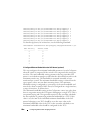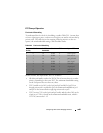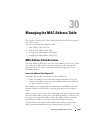
Configuring Data Center Bridging Features 1011
At time t2, a burst of LAN traffic is incoming at the rate of 4 Gbps, this burst
is allowed to borrow the unused 0.5 Gbps bandwidth from SAN TCG and
transmitted since the offered load of SAN is only 3 Gbps.
At time t3, when the offered load of IPC falls to 2 Gbps and the bursty LAN
traffic is at 6 Gbps, the available bandwidth for SAN and LAN is 4 Gbps each
according to the TCG weights, which are set as 50% each. However, ETS
allows the LAN traffic to borrow unused bandwidth from SAN traffic, and
then 5 Gbps of LAN traffic is transmitted.
Recommendations and Notes
Lossless traffic must map user priorities one-to-one onto CoS queues.
Lossless traffic must always be carried within a VLAN-tagged frame to
differentiate it from untagged best-effort LAN control traffic, such as ARP
and LLDP.
Strict-priority CoS queues may starve other CoS queues of traffic if the
offered load of the strict-priority CoS queues equals or exceeds the available
capacity of the egress interfaces. It is recommended that either a CoS-queue-
level min-bandwidth setting be utilized to ensure a minimum amount of
bandwidth is processed on the non-strict-priority queues if there is a
possibility that the strict priority traffic is not limited in bandwidth by some
other means.
It is recommended that the sum of the minimum bandwidth percentages
allocated to the group of CoS queues mapped to a single TCG be less than or
equal to the weight percentage, so that packets are not dropped due to the
congestion in the TCG.
The maximum bandwidth for a TCG should always be configured to be
greater than the minimum bandwidth or the weight of the TCG.
In the case where all TCGs are configured as strict priority, inter-TCG
scheduling is Weighted Deficit Round Robin, using the configured weights.
Configuring CoS queues with a total maximum bandwidth that is less than
the corresponding TCG weight will result in bandwidth being wasted in the
secondary scheduler.
Configuring CoS queues with a total minimum bandwidth that is greater
than the corresponding TCG weight will flood the secondary scheduler and
result in the minimum bandwidth parameter effectively overriding the TCG
weight setting.


















